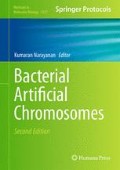Abstract
Gene therapy of inherited diseases requires long-term maintenance of the corrective transgene. Stable integration of the introduced DNA molecule into one of the host cell chromosomes is the simplest strategy for achieving this. However, genotoxicity resulting from random insertion of the transgene raises serious safety concerns that must be addressed if gene therapy is to enter the clinical mainstream. The following method makes use of the Rep integrase of adeno-associated virus to insert a transgene into the human AAVS1 site, a known “safe harbor” region within the human genome. This approach has the potential for application to novel gene therapy strategies for improved safety. In addition, with this method it is also possible to create cell lines carrying BAC transgenes in the AAVS1 site.
Access this chapter
Tax calculation will be finalised at checkout
Purchases are for personal use only
References
Shizuya H, Birren B, Kim UJ, Mancino V, Slepak T, Tachiiri Y, Simon M (1992) Cloning and stable maintenance of 300-kilobase-pair fragments of human DNA in Escherichia coli using an F-factor-based vector. Proc Natl Acad Sci U S A 89:8794–8797
Shizuya H, Kouros-Mehr H (2001) The development and applications of the bacterial artificial chromosome cloning system. Keio J Med 50:26–30
Wade-Martins R, Smith ER, Tyminski E, Chiocca EA, Saeki Y (2001) An infectious transfer and expression system for genomic DNA loci in human and mouse cells. Nat Biotechnol 19:1067–1070
Vadolas J, Wardan H, Bosmans M, Zaibak F, Jamsai D, Voullaire L, Williamson R, Ioannou PA (2005) Transgene copy number-dependent rescue of murine beta-globin knockout mice carrying a 183 kb human beta-globin BAC genomic fragment. Biochim Biophys Acta 1728:150–162
Trobridge GD (2011) Genotoxicity of retroviral hematopoietic stem cell gene therapy. Expert Opin Biol Ther 11:581–593
Wu C, Dunbar CE (2011) Stem cell gene therapy: the risks of insertional mutagenesis and approaches to minimize genotoxicity. Front Med 5:356–371
Hacein-Bey-Abina S, Von Kalle C, Schmidt M, McCormack MP, Wulffraat N, Leboulch P, Lim A, Osborne CS, Pawliuk R, Morillon E et al (2003) LMO2-associated clonal T cell proliferation in two patients after gene therapy for SCID-X1. Science 302:415–419
Hacein-Bey-Abina S, Garrigue A, Wang GP, Soulier J, Lim A, Morillon E, Clappier E, Caccavelli L, Delabesse E, Beldjord K et al (2008) Insertional oncogenesis in 4 patients after retrovirus-mediated gene therapy of SCID-X1. J Clin Invest 118:3132–3142
Wirt SE, Porteus MH (2012) Development of nuclease-mediated site-specific genome modification. Curr Opin Immunol 24:609–616
Sadelain M, Papapetrou EP, Bushman FD (2011) Safe harbours for the integration of new DNA in the human genome. Nat Rev Cancer 12:51–58
Linden RM, Ward P, Giraud C, Winocour E, Berns KI (1996) Site-specific integration by adeno-associated virus. Proc Natl Acad Sci U S A 93:11288–11294
Philpott NJ, Gomos J, Berns KI, Falck-Pedersen E (2002) A p5 integration efficiency element mediates Rep-dependent integration into AAVS1 at chromosome 19. Proc Natl Acad Sci U S A 99:12381–12385
Howden SE, Voullaire L, Wardan H, Williamson R, Vadolas J (2008) Site-specific, Rep-mediated integration of the intact beta-globin locus in the human erythroleukaemic cell line K562. Gene Ther 15:1372–1383
Amiss TJ, McCarty DM, Skulimowski A, Samulski RJ (2003) Identification and characterization of an adeno-associated virus integration site in CV-1 cells from the African green monkey. J Virol 77:1904–1915
Van Rensburg R, Beyer I, Yao X-Y, Wang H, Denisenko O, Li Z-Y, Russell DW, Miller DG, Gregory P, Holmes M et al (2013) Chromatin structure of two genomic sites for targeted transgene integration in induced pluripotent stem cells and hematopoietic stem cells. Gene Ther 20:201–214
Howden SE, Voullaire L, Vadolas J (2008) The transient expression of mRNA coding for Rep protein from AAV facilitates targeted plasmid integration. J Gene Med 10:42–50
Osoegawa K, Mammoser AG, Wu C, Frengen E, Zeng C, Catanese JJ, de Jong PJ (2001) A bacterial artificial chromosome library for sequencing the complete human genome. Genome Res 11: 483–496
Acknowledgments
This work was supported by the National Health and Medical Research Council; the Murdoch Children’s Research Institute; the Victorian Government’s Operational Infrastructure Support Program; and Thalassaemia Australia and Thalassaemia Society of New South Wales.
Author information
Authors and Affiliations
Corresponding authors
Editor information
Editors and Affiliations
Rights and permissions
Copyright information
© 2015 Springer Science+Business Media New York
About this protocol
Cite this protocol
McColl, B., Howden, S., Vadolas, J. (2015). Site-specific Integration of Bacterial Artificial Chromosomes into Human Cells. In: Narayanan, K. (eds) Bacterial Artificial Chromosomes. Methods in Molecular Biology, vol 1227. Humana Press, New York, NY. https://doi.org/10.1007/978-1-4939-1652-8_17
Download citation
DOI: https://doi.org/10.1007/978-1-4939-1652-8_17
Published:
Publisher Name: Humana Press, New York, NY
Print ISBN: 978-1-4939-1651-1
Online ISBN: 978-1-4939-1652-8
eBook Packages: Springer Protocols

